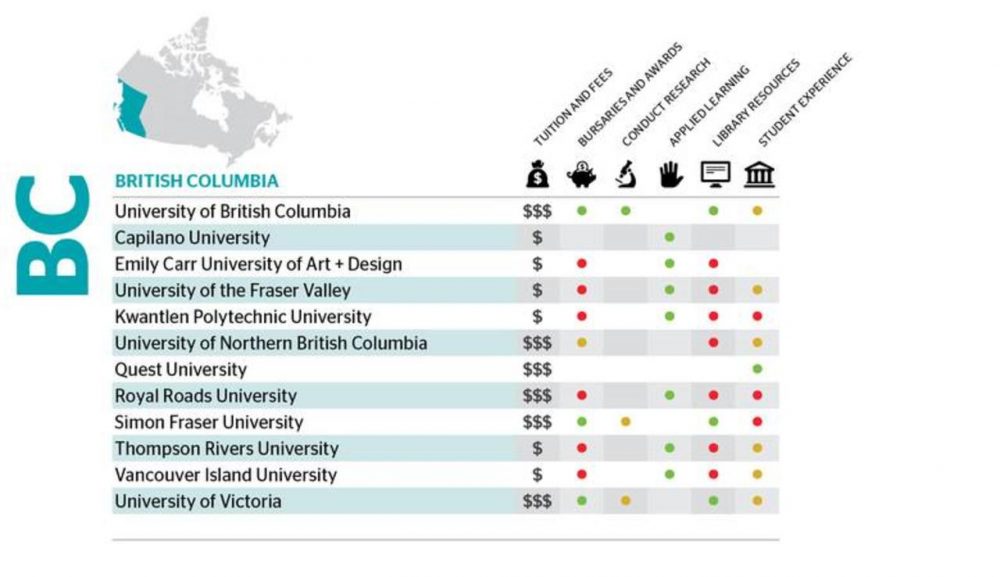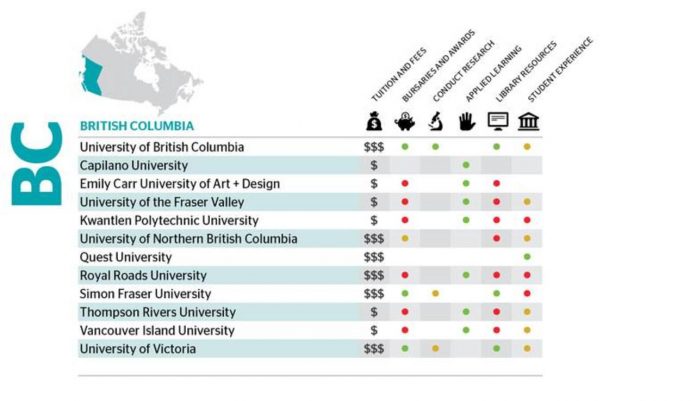The Globe and Mail’s Canadian University Report profiles more than 70 universities across Canada to show a variety of rankings, from educational experience to the feel of the campus.
Since last year, UFV’s rankings only changed in one category, student experience, in which the institution dropped from above average to average.
According to the report, the researchers gathered data on affordability, degree completion, student satisfaction, research funding, class size, innovation, and other factors. As in past years, the researchers used the National Survey of Student Engagement (NSSE), which allows students to rate their university experience in detail.
The report profile on UFV says that undergraduate students are encouraged to pursue their own research to increase their chances of obtaining scholarships, awards, and graduate-school positions, and according to results from the NSSE, “students are likely to believe that UFV provides them with job skills more than students attending other universities in the region, except for those attending Vancouver Island University.”
The report goes on to say that, “Of the student body, more than half are women, and Indigenous students comprise a significant 6 per cent,” the report said.
UFV’s strategic enrolment management plan outlines the goal of matching the number of Indigenous students to reflect the amount of Indigenous individuals living in the Fraser Valley. Currently UFV’s Indigenous student numbers meet this goal.
“The thing that struck me [about the report] is that we’re pretty consistent with our peer group, not just in B.C. but across Canada,” Eric Davis, UFV provost and vice president academic, said.

‘The breakdown’
The data was split into six categories: tuition and fees, bursaries and awards, conduct research, applied learning, library resources, and student experience.
This year, UFV’s tuition, $5,208.41, scored below average, meaning UFV’s tuition is at least $300 below the provincial average.
UFV ranked below average for bursaries and awards, as it did for 2017 and 2016.
Davis said that this is partly because UFV is a smaller campus, and not very old as an institution. Davis also mentioned that increasing financial support offerings is a huge priority of the university.
“To be able to do all the things we want to do, we need to be able to support students. It’s increasingly challenging for students, financially, to go to university,” Davis said.
UFV received no ranking for research because UFV is not considered a research institution.
In applied learning, UFV ranked above average. As outlined by UFV’s Education Plan, goal one is to prioritize learning everywhere, meaning education should happen both inside and outside the classroom. Goal five of the plan is to integrate experiential learning, which includes field work, lab experience, research, and assignment activities. Both goals relate to applied learning.
“[This ranking] reflects what we’ve prioritized for a number of years now, and we think it’s one of our strengths,” Davis said.
For library resources, UFV ranked below average. This is consistent with similar universities across B.C. All universities in B.C. ranked below average in library resources, except three of the four research institutions: SFU, UBC, and UVic.
“The reason for that is primarily because undergraduate universities are not research-intensive universities generally, and therefore they have fewer library resources,” Davis said.
Despite the below average library resources ranking, UFV continues to expand its library each year.
Davis noted that the measuring stick used in the report is primarily built around the research-intensive university’s model.
“The kinds of questions they don’t ask are those that wouldn’t matter to a big research-intensive university, because they wouldn’t do well on it; like faculty-student interaction.”


